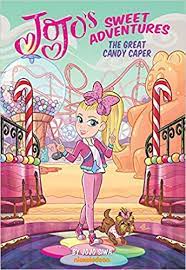It’s cute. It’s about a boy who’s not excited about the first day of school, but then when he gets on the bus, he realizes he got on the wrong bus. All the other passengers are puppies, and he finds himself at puppy school. Though he doesn’t speak Bark, he goes along with things and finds himself having a rather good day, learning how to play fetch and dig and howl. The next day he’s all excited to return, but this time finds himself on a bus filled with kitties.
Category Archives: Additional Purchase
Bright
Rachel Kim knows what success feels like. She’s been in a famous K-pop group, Girls Forever, for several years, establishing herself as one of its stars. Rachel has traveled the world and given everything to the group but is intrigued when approached with a few independent job opportunities. With the entertainment group’s blessing, Rachel embarks publically into the fashion design of purses while also privately dating a very connected young gentleman. But not all group members are happy with Rachel’s success. Girl drama mixed with suppressed passion and a little bit of paparazzi scandal propels this semi-autobiographical story. Rachel will learn that sometimes being on a new path is scary, with the unknown around the corner, but you have to try something new to get new results. Anyone who follows K-Pop will enjoy this Bright romp.
Tim Possible & the Time-Traveling T. Rex
Written by Axel Maisy
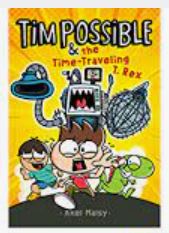
The main character, Tim Possible, is an adventurous boy who worries a lot. He and his best friend, Tito, run into a time traveling T-Rex whose time machine has turned evil. This humorous and adventuresome book will be a great addition to a library that may see a need for more books along the vein of “Captain Underpants”, “DogMan” or “Diary of a Wimpy Kid”.
The Moon from Dehradun: a Story of Partition
Written by Shirin Shamsi Illustrated by Tarun Lak
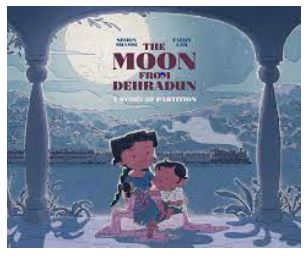
This is a beautifully written and illustrated picture book about the partition of India in 1947. It follows a family that suddenly has to leave their home and move to what is now Pakistan where they find an empty house and move in (presumably because that family had to move to what is now India). While recommended for ages 4-8, this book would be a more relevant purchase for intermediate grades. The story will be relatable to individuals who have an understanding of refugees and individuals that flee from their homelands due to fear. This book also contains maps, a glossary as well as the author’s family experiences in the back that would better explain the story to more advanced intermediate readers.
Pig Makes Art
Written by Laura Gehl Illustrated by Fred Blunt
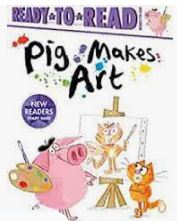
This book is an “emerging reader” book about a pig who creates art but leaves out the cat from the picture. The cat gets bored and takes a nap so the pig makes art on the cat while it’s sleeping. This makes the cat angry. In the end, pig and cat both make art together as friends. This book contains a list of word families, sight words and bonus words. It also has questions about the book on the last page.
Clementine and the Lion
It’s okay. It’s a version of the classic “kid thinks parents are ogres and would rather live without grown-up interference” trope. In this case mom got snatched by dragons and dad is lost at sea in a bottle. When an aunt shows up and tries to take over, Clementine invents an invisible paint to hide the house and get rid of the aunt. When she accidentally leaves the door open one day she ends up with a lion as a houseguest and must find a way to make peace with it and carry on in case her parents come back some day. On the one hand, a lot of kids can relate to the living-without-adults fantasy, on the other hand, it seems a bit disjointed.
I am Malala Yousafzai by Brad Meltzer
Another book in the Ordinary People Change the World Series, I am Malala Yousafzai, starts out with Malala introducing herself as an ordinary girl who likes pink, cupcakes, and pizza. The narrative quickly turns to how girls in her country are not treated the same as boys. It discusses the school started by her father and her quest to seek education. It does depict when she was shot and does show someone holding a gun. The illustrations show Malala as a young girl throughout the entire book. The end includes a timeline and photographs of Malala.
Different Kinds of Fruit by Kyle Lukoff
From the author of the Newbery Honor book “Too Bright to See” and the picture book “When Aidan Became a Brother,” Kyle Lukoff presents us with a novel on the queer community through the eyes of sixth grade Annabelle. When a vocal, cool binary student, Bailey, joins her class, Annabelle is instantly infatuated with them, and begins to wonder if this is actually a crush. When she brings Bailey home, Annabelle’s parents instantly act awkward and seem to be discouraging their friendship. Misreading their attitude about Bailey’s gender identity, her parents share with Annabelle that her dad is not only transgender, but a seahorse father. (He was the one who birthed Annabelle when it was discovered that her mother was unable to have children). Once this is out in the open, Annabelle, Bailey, and their families get involved in the Spectrum Families chapter in Tahoma Falls and Seattle, WA. Annabelle continues to try to “figure out which letter in LGBTQ+ applied to me, now that I know that I was something.” National Coming Out Day (NCOD) is quickly approaching and Annabelle feels pressured to figure it out soon.
From the very beginning, I saw this is as an “instructive manual” on how to “they/them” and teach terms such as butch, femme, seahorse, pan, and more. While I respect this possible motive by the author, for me, it drove the book rather than an interesting plot. I believe there are better books out there on questioning your sexual and gender identity, but if you’re looking to add to your collection, this may appeal to lower middle school students.
When You Call My Name by: Tucker Shaw
This is an LGBTQ+ Romance set in the early 90s. Usually, I love books set within this time period because I was a teen during that era; however, this one falls short for me. The pop culture references sprinkled within the book are pretty obscure; I worry today’s teens will not have enough knowledge to understand the reference and grow bored of it, unable to relate.
I appreciated the way the author told of society’s attitude toward the LGBTQ+ community during that time period; however, I feel as though parts were very trite and predictable.
I also dislike the title – it feels like it’s trying to allude to Call Me by Your Name by Aciman (which it does not compare).
I do think that our high school libraries will have an audience for this title. I am curious to hear what today’s teens say about it it.
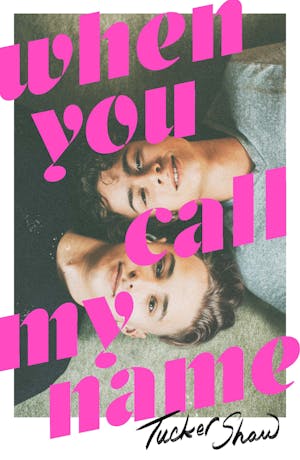
The Great Candy Caper by JoJo Siwa
Nickolodeon;s JoJo Siwa is invited to sing at the opening of a new candy-themed park, SugarPalooza, and takes her two friends, Grace and Kyra for a special tour before the show. The park’s owner’s daughter, Avery, and her friend, Jada, join the tour. Something’s not quite right, but JoJo can’t figure it out. Actually, there’s a lot that isn’t right, including a big mess of chocolate as the chocolate pumps malfunction. Candy is everywhere, rides are breaking down and Grace is missing! JoJo and Kyra spring into action to fix both calamities. The chocolate malfunction is fixed, thanks to help from Jada and their tour guide, Maddy. And, they locate Grace, who has a history with Avery (not a nice girl). But, Grace saves Avery despite their bad relationship, and Avery apologizes. The show must go on and, after a cleanup, the park opens and JoJo performs for the adoring crowds. Everything is sweet in this Candy Caper.
This graphic novel is full of color and a simple story line (girl drama that is fixed in the end). The font is fairly small. The illustrations are set in one to five panes per page. Fans of JoJo Siwa will enjoy this book and a wider audience might like the adventurous romp through SugarPalooza.
Cactus and Flower : a book about life cycles by Sarah Williamson
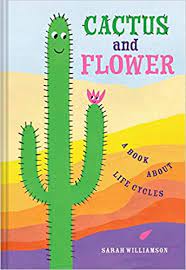
Cactus and Flower are best friends. They watch the sky as it changes color throughout the day. They visit with their desert animal friends and they watch the stars. These are “Butterfly Days”. One day, one of Flower’s petals drops and then another and another, until…flower is gone. Cactus is so sad. Even the beautiful butterflies can’t cheer him up. But, sadness eventually changes to sweet memories of his friend, Flower. One day, a little green bud appears on Cactus and it turned into a new Flower. “Butterfly Days” are back.
This is a simple, sweet rendition of the life cycle. While the botany might not be totally accurate, the desert animals are there and the basic story line works. Illustrations are bright and simple. Endpapers add interest with clouds in the front and their constellation counterparts in the back. This would be a nice introduction to plant life cycles.
Stage Door to Terror by Robert Quackenbush
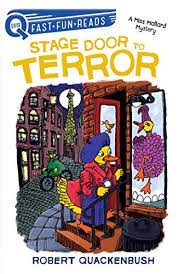
Miss Mallard is in Paris visiting her nephew, Inspector Willard Widgeon. They decide to go to the theater performance of Claudine, granddaughter of family friend (and retired performer) Lily Pilet. In her day, Lily was a famous dancer, who was even rumored to be courted by royalty and showered with jewels. They are especially excited to see Claudine’s recreation of Lily’s famous “Rain of Light” dance. Claudine enters the stage and is swept up and ducknapped! Fortunately, Miss Mallard and Willard quickly discover her tied up in the attic of the theater. Unfortunately, they also discover that her dressing room has been ransacked by the ducknappers.
Upon further discussion, Claudine tells them that her grandmother sent her her bejeweled costume for the show. This costume is studded with real gems. Lily has some later misgivings and sends her a reproduction of the costumer and asks Claudine to hide the real one. Claudine has a claim ticket for the suitcase with the costume, which is at the railroad station. The problem? The ticket is torn and only Claudine’s assistant, Marie, knows the station name. A rush through all the major Paris landmarks ensues and they find Marie in a cafe. They “hatch” a plan to catch the thieves with a fake suitcase and claim ticket before retrieving the real bejeweled costume and their plan works. The thieves/ducknappers are apprehended and the valuable costume is back with Claudine.
This book is intended for those students that are ready to move on from picture books to early chapter books. The font is large and there are numerous half page illustrations. There is also a glossary and question page in the back of the book. The only sticking point of this story is the unfamiliar setting (Notre Dame, Montmartre, Eiffel Tower, etc.) of Paris. Young readers might become bogged down a bit, instead of just enjoying the story. Otherwise, this is nice stepping stone to chapter books.
Kingston and the Echoes of Magic, by Rucker Moses and Theo Gangi
Since this book is the sequel to Kingston and the Magician’s Lost and Found , it took me a bit to figure out the plot at the beginning of the book. This is one that I think would be better read AFTER the first book in the series. Eventually, enough clues about what had happened to Kingston and his friends in the previous book allowed me to move forward with this one. The story is full of time portals, magical items, echo loops, and missing people. Kingston and his friends must save the world from another magician trying to reset it in an alternate reality. I enjoyed the dive into Egyptian mythology and the fast pace of the story though the twists in the plot may leave some readers puzzled. There were LOTS of twists and turns and characters met at different points in their lives which could be confusing if the reader isn’t really paying attention. If the reader loved the first in the series, I think this will help finish answering questions that must have been left unanswered. Skip this one if you don’t also have Book 1.

The Big Mix-Up! by Dana Regan
With his moped and trailer, Mike delivers all over the town of Happy River. When Mike starts having trouble reading his blurry list, he makes mistakes with his deliveries. Finally Mike goes to see Doc Wells for an eye exam. With his new glasses he can now read his list and make the correct deliveries. An additional purchase for those looking for more books for emergent readers.
Currently there are two books in the Mike Delivers series.
Slow Down: 50 Mindful Moments in Nature by Rachel Williams
Only by slowing down, you can truly appreciate the breathtaking complexity and precision of nature. Slow Down identifies fifty amazing natural processes and breaks down those processes into stages. Each of the 50 mindful moments starts with a statement connecting with the readers experiences followed by a brief summary. Over the next page and a half, the captions and illustrations walk the reader slowly through the highlighted moments.
Use as a tool to slow down and appreciate nature or as a model for sequencing or science writing.
Includes Table of Contents, Index, Further Reading (mindfulness and nature), and Selected Bibliography
Sylvie by Jean Reidy
Sylvie the spider loves the people in her building and one day she notices that something seems wrong. Worried that not everyone appreciates a spider that calls attention to herself, she finds the courage to unite the people in the building. Finally she feels the appreciation and friendship that she has been longing for.
The author also wrote the book, Truman, and Truman the tortoise makes an appearance in this book as well. It was fun to see that tie in. The illustrations in the book are colorful and help tell the story, but the storyline is difficult to follow and requires inferencing.
I am I. M. Pei by Brad Meltzer
I am I. M. Pei is a part of the Ordinary People Change the World Series by Brad Meltzer. It begins with I. M. Pei’s childhood and is told in the first person. The book is written in a conversational tone and the illustrator, Christopher Eliopoulos includes comic inserts on various pages. There is a lot of text on the pages, but it is broken up with illustrations. As a child, I. M. Pei is drawn as a miniature adult and in the pages where he is an adult, he is much shorter and more childlike than the other adults in the illustrations. This book is only a brief look at his life. The themes of persistence and grit come across throughout the biography. When talking about the renovation of the Louvre, there is a page with a pop-up Louvre. A timeline of his life and pictures of I. M. Pei are included at the end of the book.
Little Red and the Cat Who Loved Cake
by Barbara Lehman and illustrated by Barbara Lehman
This wordless book is rich in illustrative storytelling The story chronicles a cat’s love of cake and the distress it is experiencing as the cake he sees being baked is obviously not intended for him. He follows Little Red as he goes to visit his grandmother, in hopes of receiving a piece of this cake. Instead, he settles for it in his dreams that night.
The story becomes endearing, at the end, when the author challenges the reader to find 24 lost sheep scattered thougouht the illustrations in the story. After this hunt, it really begins.There are four pages of pictures from the story, which have references to fairy tales or nursery rhymes and the reader is asked to find them Also included, is the full verse to every nursery rhyme and title to every fairy tale referenced. This book is recommend as a tool to open up rich discussion and discovery with a young child or classroom!
Trees
by Tony Johnston, Illustrated by Tiffany Bozic
Large picture book with artistic pages celebrating the beauty of trees and the natural world. The artwork by Tiffany Bozic is stunning. The words are in prose, like a long poem separated into stanzas or lines on each page. This book would make a beautiful addition to a unit on trees, natural world, earth day, poetry month, or simply to revel in the beauty of the written words and artistic talent.
A nice addition is the last two pages of this book have an author’s note with additional facts and information about trees and forests, including the idea of of nine year old Felix Finkbeiner known as Plant-for-the-Planet. In order to stop global warming, children of all countries could plant one million trees. Also, Illustrators not about trees and Suggestions for Further Reading, and Resources as well as a sweet List of Trees in This Book, including thumbnail pictures.
In Our Garden
By Pat Zietlow Miller and illustrated by Melissa Crowton
From a small idea to a rooftop garden, our mail character Miller sees her vision through to the end. She has recently moved to a big city from another country, where they used to grow their own food. She is inspired to work with her teacher and classmates to build a roof top garden, It took patience and hard work, but she didn’t give up. The whole community helps and shares the labors, building the beds, planting seeds and harvesting!
Darling pictures which feature students and staff in the community and school as varying ethnicity coming together as one~
The Brave Little Gorilla
It’s got a really good message about not making judgments without all the facts. It tells about a little gorilla who’s been sent by his grandfather to pick up some eggs that crane offered to leave for them. But unfortunately a mischievous monkey decides to follow along and watch him from afar, and all along the journey that monkey misinterprets what he sees. Worse yet, the monkey shares his accusations with other jungle dwellers who accept them at face value. By the time the little gorilla is about to arrive home with his precious cargo, the others are ready punish him for a list of crimes he didn’t commit. Luckily he is rescued when a giant hippo emerges from the river with his little bird who corrects the accusatory monkeys by announcing he’d been up close and personal to all the gorilla’s transactions, and scolds them for making accusations based on things they have not seen with their own eyes and heard with their own ears. Though I like the message, I thought both the telling of it and the illustrations were a bit flat.
The Little Book of Joy
Okay, so I hate to be down on joy, and I’m not even really down on this sweet little book, I just don’t think it is meant to be a library book. It’s meant to be part of the decor in a nursery or children’s room, where it sits on display all year long and is occasionally pulled down to peruse for an idea. I almost even marked it as “reference,” but then that didn’t really seem to fit it, even though I imagine it being used kind of like a reference book for a bored kid. It’s got a page for every day of the year, with ideas for things to try, along with bits of information about that day’s topic and questions for kids to ponder. The illustrations are really sweet, but kind of keep the target audience young, even though older kids would be able to make more independent use of the information. My “additional purchase” recommendation is really kind of a compromise choice: I have a hard time recommending it for library use, but would absolutely recommend it as a gift for a baby shower.
Solitary Animals: Introverts of the Wild by Joshua David Stein, art by Dominique Ramsey
The lyrical text describes animals that live in groups and using the collective nouns and then names an animal that lives alone. I like the use of collective nouns and the text is engaging. I was expecting to learn more information about the solitary animals, but I did learn which animals live in groups and what the group names are called. There is a page at the back that answers some questions about why some animals live alone. The artwork in the book is bright and vibrant and is eye-catching.
The Great Paint by Alex Willmore
Frog is an artist but he needed some inspiration for his art because his swamp was dull. He went around to his friends in the forest and adds his artistic interpretations. His friends do not appreciate him beautifying everything. He realizes he got carried away and returns to his swamp to create his own art show. He invites his friends to his art show so he can apologize.
Frog is fun and his personality comes through in the illustrations. He learns that he needs to respect other’s spaces. I do wish it had shown Frog helping his friends clean up the messes that he made.
The book was originally published in London, so there is some spelling differences in the book that kids might notice (colour/color). The text changes between black and white, but sometimes the page is dark and the text is still black which makes it a challenge to read.
Toucan with Two Cans
It’s a controlled-text early reader that plays a bit with sound-alike words and homonyms. It basically tells the story of a juggling toucan juggling cans. It has a certain element of the tongue twister about it that makes it kind of fun, but sometimes the use of the same words in different contexts makes building meaning from the story a bit confusing.

